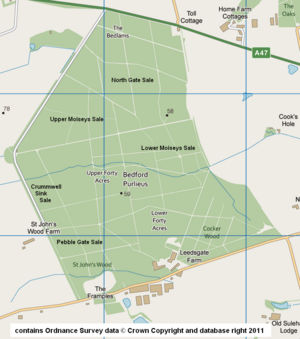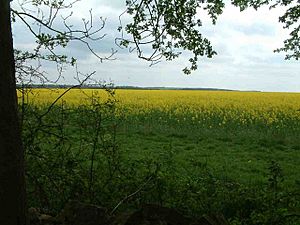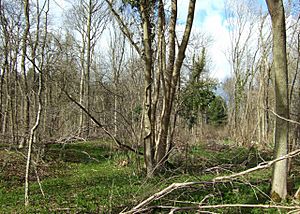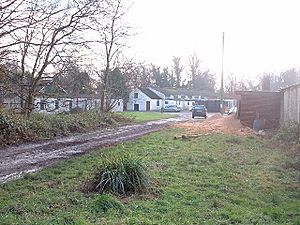Bedford Purlieus National Nature Reserve facts for kids
| Site of Special Scientific Interest | |
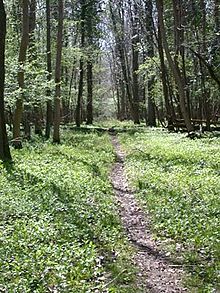 |
|
| Area of Search | Cambridgeshire |
|---|---|
| Coordinates | 52°35′00″N 0°27′33″W / 52.5833°N 0.4591°W |
| Interest | Biological |
| Area | 211 hectares (520 acres) |
| Notification | 1969 |
Bedford Purlieus is an amazing ancient woodland in Cambridgeshire, UK. It covers about 211 hectares (that's like 521 football fields!). This special forest is a National Nature Reserve (NNR). It's looked after by the Forestry Commission.
You can find Bedford Purlieus about 10 kilometers south of Stamford. It's also 14 kilometers west of Peterborough. The wood is in Cambridgeshire but is very close to Northamptonshire.
This woodland has been around for a very long time. People think it has been continuously wooded since Roman times. It might even have been a forest since the last ice age! It's famous for having more types of plants than almost any other lowland wood in England.
Contents
A Special Place for Nature
Bedford Purlieus became a National Nature Reserve (NNR) in the year 2000. NNRs are places that are super important for nature. Most NNRs in England are managed by Natural England. But Bedford Purlieus is managed by the Forestry Commission. It's open for everyone to visit during the day.
This woodland is known for its huge variety of plants. It has more types of woodland flowers than almost any other forest in England. In 1975, experts found 462 different kinds of vascular plants here!
Why is it so rich in plants? It's because the ground has many different soil types. Some areas have very chalky limestone, while others have sandy or silty soil. Also, the way the wood has been managed over hundreds of years has helped. Things like coppicing (cutting trees to let them regrow) and even old wartime buildings have created many different habitats. This helps lots of different plants and animals live here.
Managed by the Forestry Commission
The Forestry Commission has owned Bedford Purlieus since 1933. For many years, the main goal was to grow as much timber (wood) as possible. But in the 1970s, people started to care more about the forest's natural value. They also wanted to make it a place for people to enjoy.
Growing Trees for Wood
When the Forestry Commission bought Bedford Purlieus, many valuable trees had already been cut down. So, they started planting new trees in the 1930s and 1940s. They planted oak trees, but also larch, Scots pine, and Corsican pine. These pine trees are not native to England.
Even though planting non-native trees can sometimes harm a forest, it actually helped Bedford Purlieus survive. The forest today has a mix of planted trees, self-grown trees, and old coppice stumps that have regrown. This mix of trees means the forest still has many different kinds of plants. You can find oak, lime, elm, hazel, ash, field maple, sycamore, and birch trees here.
There's one part of the wood called The Bedlams. This area isn't ancient woodland. It was planted with different trees like beech and Norway spruce in the 19th and 20th centuries. Also, an old iron quarry on the east side was planted with Corsican pine.
Protecting Nature and Welcoming Visitors
In 1975, a big meeting was held to talk about how to manage Bedford Purlieus. Experts from different groups came together. They realized that even though the forest was used for timber, this use also helped it survive.
During the 1970s, the Forestry Commission started to focus more on protecting nature. They also wanted to make their forests places for people to visit. The meeting helped create a plan for Bedford Purlieus. This plan suggested bringing back coppicing in some areas. It also recommended removing some of the non-native pine trees.
Thanks to these efforts, Bedford Purlieus became a National Nature Reserve in 2000. In 2005, it received money to help with conservation work. This money helped the Forestry Commission bring back coppicing, create open grassy areas, and remove unwanted trees.
The Forestry Commission wants people to enjoy Bedford Purlieus. They encourage "quiet recreation" to protect the plants and animals. There's a car park you can use, and many paths to walk on. The wood is open every day during daylight hours.
The Duke of Bedford's Forest
For 400 years, Bedford Purlieus was part of a huge estate owned by the Russell family. They were Earls, and later Dukes of Bedford. This family connection is why the forest is called "Bedford Purlieus." Under their care, the forest changed a lot in size and character.
From Thornhaugh Woods to Purlieus
Before 1639, this forest was known as Thornhaugh Woods. The name Bedford Purlieus came from its link to the Dukes of Bedford. It also shows its older history as part of a Royal Forest.
The Russell family got these woods in 1526. John Russell married Anne Sapcote, who owned Thornhaugh Woods. Later, he became an Earl and was given a huge estate by King Henry VIII.
In 1639, King Charles I made the 5th Earl of Bedford pay money to "disafforest" his woods. This meant the woods were no longer under strict Forest Law. The King needed money for the Civil War. After this, the woods became known as "purlieus." A purlieu is land that was once part of a Royal Forest but was legally removed from it.
The document from 1639 said that for £200, the 1,648 acres of woods were "altogether dissaforested." This meant the Earl could now hunt freely and cut down any trees he wanted. After Charles II made the Earl a Duke in 1694, the woods were called 'the Duke of Bedford's Purlieus'.
Shrinking Forest
The woods stayed with the Russell family for many more generations. But not all of it remained forest. In 1639, about 1,000 acres were woodland. Today, only half of that is left. Between 1862 and 1868, the western half of the wood was cleared and turned into farmland.
Old newspaper articles from that time describe how men were paid to "grub up" the trees. This meant digging up the roots and clearing the land. They talked about a "Centre Tree" that used to be in the middle of the original forest. All the paths led to it, "as all roads lead to Rome."
Woodland Sections
The forest is divided into different sections, or "compartments." These sections have had the same names for a very long time, even back to medieval times. This helps us know that it's the same ancient forest.
In 1904, the 11th Duke of Bedford decided to sell the whole Wansford Estate, including Bedford Purlieus. It was bought by a wealthy young man, but just nine years later, he sold Bedford Purlieus to a timber merchant. This merchant probably cut down all the valuable trees. Then, in 1933, the Forestry Commission bought the wood, as we learned earlier.
Ancient Roman History
People believe Bedford Purlieus has been a woodland since at least Roman times. It might even be much older, perhaps dating back to when the ice age ended. But the Romans did not leave it untouched.
You can still see signs of ancient activity in the woods today. There are old banks from the Middle Ages, small quarry pits, and signs of Roman industry. In the 1800s, an early archaeologist found evidence of a Roman villa and iron working furnaces. In 1965, more furnaces were found.
In 2011, the TV show Time Team did an archaeological dig here. They used special technology called LIDAR to map the ground. They confirmed that the Romans were digging for iron in the woods. They also found Roman iron smelting sites. This means Bedford Purlieus was an important center for iron for the Romans in Britain. They even found a Roman bath-house, which might have been part of a manager's home.
How did the forest survive all this industry? The Romans needed iron and fuel (wood) for their work. Since both were available here, it was a good location. To make sure they always had fuel, they likely used a coppicing system. This means they cut trees in a way that allowed them to regrow. This method would have helped the woodland stay alive throughout and after the Roman period.
Wartime Use
During World War II, Bedford Purlieus was used by the RAF Kings Cliffe air base. The airmen's living quarters were spread out in the woods. This was to keep them safer from air raids. You can still find some old building foundations today. The buildings in the St John's Wood section, now called Leedsgate Farm, included the theater, gym, and chapel for the air base.
Images for kids


